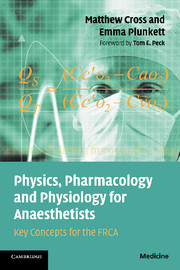Book contents
- Frontmatter
- Contents
- Acknowledgements
- Preface
- Foreword
- Introduction
- Section 1 Mathematical principles
- Section 2 Physical principles
- Simple mechanics
- The gas laws
- Laminar flow
- Turbulent flow
- Bernoulli, Venturi and Coanda
- Heat and temperature
- Humidity
- Latent heat
- Isotherms
- Solubility and diffusion
- Osmosis and colligative properties
- Resistors and resistance
- Capacitors and capacitance
- Inductors and inductance
- Defibrillators
- Resonance and damping
- Pulse oximetry
- Capnography
- Absorption of carbon dioxide
- Cardiac output measurement
- The Doppler effect
- Neuromuscular blockade monitoring
- Surgical diathermy
- Cleaning, disinfection and sterilization
- Section 3 Pharmacological principles
- Section 4 Pharmacodynamics
- Section 5 Pharmacokinetics
- Section 6 Respiratory physiology
- Section 7 Cardiovascular physiology
- Section 8 Renal physiology
- Section 9 Neurophysiology
- Section 10 Statistical principles
- Appendix
- Index
Cleaning, disinfection and sterilization
Published online by Cambridge University Press: 15 January 2010
- Frontmatter
- Contents
- Acknowledgements
- Preface
- Foreword
- Introduction
- Section 1 Mathematical principles
- Section 2 Physical principles
- Simple mechanics
- The gas laws
- Laminar flow
- Turbulent flow
- Bernoulli, Venturi and Coanda
- Heat and temperature
- Humidity
- Latent heat
- Isotherms
- Solubility and diffusion
- Osmosis and colligative properties
- Resistors and resistance
- Capacitors and capacitance
- Inductors and inductance
- Defibrillators
- Resonance and damping
- Pulse oximetry
- Capnography
- Absorption of carbon dioxide
- Cardiac output measurement
- The Doppler effect
- Neuromuscular blockade monitoring
- Surgical diathermy
- Cleaning, disinfection and sterilization
- Section 3 Pharmacological principles
- Section 4 Pharmacodynamics
- Section 5 Pharmacokinetics
- Section 6 Respiratory physiology
- Section 7 Cardiovascular physiology
- Section 8 Renal physiology
- Section 9 Neurophysiology
- Section 10 Statistical principles
- Appendix
- Index
Summary
Maintaining cleanliness and sterility is involved in everyday practice but, for the most part, is not under the direct control of anaesthetists. Nevertheless, a familiarity will be expected with the main definitions and methods of achieving adequate cleanliness.
Cleaning
The process of physically removing foreign material from an object without necessarily destroying any infective material.
Disinfection
The process of rendering an object free from all pathogenic organisms except bacterial spores.
Sterilization
The process of rendering an object completely free of all viable infectious agents including bacterial spores.
Decontamination
The process of removing contaminants such that they are unable to reach a site in sufficient quantities to initiate an infection or other harmful reaction.
The process of decontamination always starts with cleaning and is followed by either disinfection or sterilization.
- Type
- Chapter
- Information
- Physics, Pharmacology and Physiology for AnaesthetistsKey Concepts for the FRCA, pp. 76 - 77Publisher: Cambridge University PressPrint publication year: 2008



